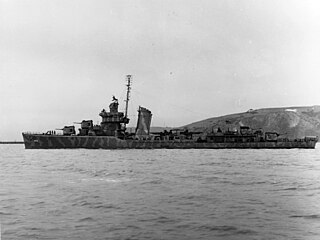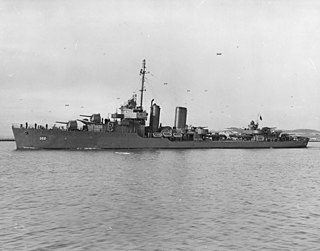
USS Pensacola (CL/CA-24) was a cruiser of the United States Navy that was in service from 1929 to 1945. She was the lead ship of the Pensacola class, which the navy classified from 1931 as heavy cruisers. The third Navy ship to be named after the city of Pensacola, Florida, she was nicknamed the "Grey Ghost" by Tokyo Rose. She received 13 battle stars for her service.

USS Portland (CL/CA–33) was the lead ship of the Portland class of cruiser and the first ship of the United States Navy named after the city of Portland, Maine. Launched in 1932, she completed a number of training and goodwill cruises in the interwar period before seeing extensive service during World War II, beginning with the Battle of the Coral Sea in 1942, where she escorted the aircraft carrier Yorktown and picked up survivors from the sunken carrier Lexington. She screened for Yorktown again in the Battle of Midway, picking up her survivors as well. She then supported the carrier Enterprise during the initial phase of the Guadalcanal Campaign later that year, and was torpedoed during the Naval Battle of Guadalcanal. The torpedo inflicted heavy damage which put her out of action for six months as she was repaired in Sydney, Australia, and later San Diego, California.

USS Nashville (CL-43) was a Brooklyn-class cruiser. She was laid down on 24 January 1935 by New York Shipbuilding Corporation, Camden, New Jersey. She was launched on 2 October 1937, sponsored by Misses Ann and Mildred Stahlman and commissioned on 6 June 1938.

The Mahan-class destroyers of the United States Navy were a series of 18 destroyers of which the first 16 were laid down in 1934. The last two of the 18, Dunlap and Fanning, are sometimes considered a separate ship class. All 18 were commissioned in 1936 and 1937. Mahan was the lead ship, named for Rear Admiral Alfred Thayer Mahan, an influential historian and theorist on sea power.

USS Hughes (DD-410) was a World War II-era Sims-class destroyer in the service of the United States Navy.

USS Helm (DD-388) was a Bagley-class destroyer in the United States Navy during World War II. She was named for Rear Admiral James Meredith Helm. Helm received 11 battle stars for her World War II service in the Pacific.

USS Mugford (DD-389), a Bagley-class destroyer, was the 2nd ship of the United States Navy to be named for James Mugford, who commanded the schooner Franklin in the Continental Navy, serving through 1775.

USS Braine (DD-630), a Fletcher-class destroyer, was a ship of the United States Navy named for Rear Admiral Daniel L. Braine (1829–1898), who served in the American Civil War. Constructed by Bath Iron Works in Bath, Maine, the ship was launched on 7 March 1943 and commissioned on 11 May 1943. The destroyer took part in the United States' naval campaign in the South Pacific during World War II. Following the war, the vessel was decommissioned and placed in reserve. During the Korean War, Braine was recommissioned and operated in the Mediterranean Sea before being decommissioned for the final time by the United States Navy in 1971. The destroyer was sold to Argentina and renamed ARA Almirante Domecq Garcia after Admiral Manuel Domecq Garcia and served with the Argentinian Navy until disposed of as a target ship in 1983.

USS Schroeder (DD-501), a Fletcher-class destroyer, was a ship of the United States Navy, named for Rear Admiral Seaton Schroeder (1849–1922). Entering service in 1943, the ship saw action during World War II, participating in the Battle of Tarawa. Following the war the destroyer was placed in reserve, remaining in this state until 1972. She was sold for scrap in 1974.

USS Sigsbee (DD-502), a Fletcher-class destroyer, was a ship of the United States Navy named for Rear Admiral Charles D. Sigsbee (1845–1923).

USS McCalla (DD-488), a Gleaves-class destroyer, was the second ship of the United States Navy to be named for Bowman H. McCalla, who served during the Spanish–American War and would eventually attain the rank of rear admiral.

The third USS Macdonough (DD-351) was a Farragut-class destroyer in the United States Navy during World War II. She was named for Thomas Macdonough.

The third USS Worden (DD-352) was a Farragut-class destroyer in the United States Navy during World War II. She was named for John Lorimer Worden.

The second USS Gridley (DD-380) was the lead ship of her class of destroyers in the United States Navy. She was the second US Navy ship named for Charles Vernon Gridley. She served with distinction in the Pacific Theater during the Second World War and shared in the sinking of a Japanese submarine.

USS Patterson (DD-392), a Bagley-class destroyer, was the second ship of the United States Navy to be named for Daniel Todd Patterson, an officer of the US Navy who served in the Quasi-War with France, First Barbary War, and the War of 1812.

The second USS Conyngham (DD-371) was a Mahan-class destroyer used in the United States Navy before and during World War II. She was named after Gustavus Conyngham.

USS Lardner (DD-487), a Gleaves-class destroyer, was the second United States Navy ship to be named for Rear Admiral James L. Lardner, a Naval officer during the American Civil War. Lardner received 10 battle stars for World War II service.

USS Harrison (DD-573) was a Fletcher-class destroyer of the United States Navy. She was second Navy ship of that name.

USS Sterett (DD-407) was a Benham-class destroyer in the United States Navy. She was the second Navy ship named for Andrew Sterett.

USS Farenholt (DD-491) was a Benson-class destroyer in the United States Navy during World War II. She was the second ship named for Admiral Oscar Farenholt.




















